An Artificial Intelligence Application for Post-Earthquake Damage Mapping in Palu, Central Sulawesi, Indonesia
Abstract
1. Introduction
2. Data and Methods
2.1. Satellite Imagery Data
2.2. Artificial Neural Network
2.3. Support Vector Machine
2.4. Decorrelation Method
3. Results
3.1. Landsat Image Classification of ANN and SVM Classifiers
3.2. Landsat Images: Decorrelation of the ANN and SVM Classifiers
3.3. Sentinel Image Classification using ANN and SVM Classifiers
3.4. Sentinel Image Decorrelation of ANN and SVM Classifiers
3.5. Conformity of the ANN- and SVM-derived Damage Maps based on Landsat and Sentinel Images
4. Discussion
5. Conclusions
Author Contributions
Funding
Conflicts of Interest
References
- BNPB Gempabumi Sulawesi Tengah. Available online: https://sites.google.com/view/gempadonggala/beranda?authuser=0 (accessed on 22 November 2018).
- USGS Earthquake Hazard Program. M 7.5—70 KM N of Palu, Indonesia. Available online: https://earthquake.usgs.gov/earthquakes/eventpage/us1000h3p4/executive (accessed on 22 November 2018).
- AHA Centre. Situation Update No. 15—Sulawesi Earthquake. Available online: https://ahacentre.org/situation-update/situation-update-no-15-sulawesi-earthquake-26-october-2018/ (accessed on 23 November 2018).
- AHA Centre. Situation Update No. 7—Sulawesi Earthquake. Available online: https://ahacentre.org/wp-content/uploads/2018/10/AHA-Situation_Update-no7-Sulawesi-EQ-rev2.pdf (accessed on 21 October 2018).
- BMKG. Gempabumi Tektonik Kabupaten Donggala. Available online: https://www.bmkg.go.id/berita/?p=gempabumi-tektonik-m7-7-kabupaten-donggala-sulawesi-tengah-pada-hari-jumat-28-september-2018-berpotensi-tsunami&lang=ID&tag=press-release (accessed on 22 October 2018).
- Gomez, J.M.; Madariaga, R.; Walpersdorf, A.; Chalard, E. The 1996 earthquakes in Sulawesi, Indonesia. Bull. Seismol. Soc. Am. 2000, 90, 739–751. [Google Scholar] [CrossRef]
- Horspool, N.; Pranantyo, I.; Griffin, J.; Latief, H.; Natawidjaja, D.H.; Kongko, W.; Cipta, A.; Bustaman, B.; Anugrah, S.D.; Thio, H.K. A probabilistic tsunami hazard assessment for Indonesia. Nat. Hazards Earth Syst. Sci. 2014, 14, 3105–3122. [Google Scholar] [CrossRef]
- Rahmadaningsi, W.S.N.; Assegaf, A.H.; Setyonegoro, W. Study of characteristics of tsunami based on the coastal morphology in north Donggala, Central Sulawesi. J. Phys. Conf. Ser. 2018, 979, 012020. [Google Scholar] [CrossRef]
- Muntohar, A.S. Research on earthquake-induced iquefaction in Padang City and Yogyakarta Area. J. Geotek. Hatti IX 2014, 1, 0853–4810. [Google Scholar]
- Xu, C. Preparation of earthquake-triggered landslide inventory maps using remote sensing and GIS technologies: Principles and case studies. Geosci. Front. 2014, 6, 825–836. [Google Scholar] [CrossRef]
- Kochersberger, K.; Kroeger, K.; Krawiec, B.; Brewer, E.; Weber, T. Post-disaster remote sensing and sampling via an autonomous helicopter. J. Field Robot. 2014, 31, 510–521. [Google Scholar] [CrossRef]
- Hoque, M.A.A.; Phinn, S.; Roelfsema, C.; Childs, I. Tropical cyclone disaster management using remote sensing and spatial analysis: A review. Int. J. Disaster Risk Reduct. 2017, 22, 345–354. [Google Scholar] [CrossRef]
- Yamazaki, F.; Liu, W. Remote sensing technologies for post-earthquake damage assessment: A case study on the 2016 Kumamoto earthquake. In Proceedings of the Keynote Lecture, 6th Asia Conference on Earthquake Engineering, Cebu City, Phillipine, 22–24 September 2016; p. 8. [Google Scholar]
- Boccardo, P.; Tonolo, F.G. Remote sensing’s role in emergency mapping for disaster response. In Engineering Geology for Society and Territory; Lollino, G., Manconi, A., Guzzetti, F., Culshaw, M., Bobrowsky, P., Luino, F., Eds.; Springer: Cham, Switzerland, 2015; Volume 5, pp. 17–24. [Google Scholar] [CrossRef]
- Ezequiel, C.A.F.; Cua, M.; Libatique, N.C.; Tangonan, G.L.; Alampay, R.; Labuguen, R.T.; Favila, C.M.; Honrado, J.L.E.; Canos, V.; Devaney, C.; et al. UAV aerial imaging applications for post-disaster assessment, environmental management and infrastructure development. In Proceedings of the 2014 International Conference on Unmanned Aircraft Systems (ICUAS), Orlando, FL, USA, 27–30 May 2014; IEEE: New York, NY, USA, 2014; pp. 274–283. [Google Scholar]
- Yoon, B.; Choi, J. Analysis of land cover changes based on classification results using PlanetScope satellite images. Korean J. Remote Sens. 2018, 34, 671–680. [Google Scholar]
- Piao, Y.; Lee, H.S.; Kim, K.; Lee, K. Methodology to apply low spatial resolution optical satellite images for large-scale flood mapping. Korean J. Remote Sens. 2018, 34, 787–799. [Google Scholar]
- Bui, D.T.; Tran, A.T.; Harald, K.; Pradhan, B.; Inge, R. Spatial prediction models for shallow landslide hazards: A comparative assessment of the efficacy of support vector machines, artificial neural networks, kernel logistic regression, and logistic model tree. Landslides 2016, 13, 361–378. [Google Scholar] [CrossRef]
- Alizadeh, M.; Ngah, I.; Hashim, M.; Pradhan, B.; Pour, A. A hybrid analytic network process and artificial neural network (ANP-ANN) model for urban earthquake vulnerability assessment. Remote Sens. 2018, 10, 975. [Google Scholar] [CrossRef]
- Dou, J.; Yamagishi, H.; Pourghasemi, H.R.; Yunus, A.P.; Song, X.; Xu, Y.; Zhu, Z. An integrated artificial neural network model for the landslide susceptibility assessment of Osado Island, Japan. Nat. Hazards 2015, 78, 1749–1776. [Google Scholar] [CrossRef]
- Pradhan, B.; Lee, S. Delineation of landslide hazard areas on Penang Island, Malaysia, by using frequency ratio, logistic regression, and artificial neural network models. Environ. Earth Sci. 2010, 60, 1037–1054. [Google Scholar] [CrossRef]
- Shahri, A.A. Assessment and prediction of liquefaction potential using different artificial neural network models: A case study. Geotech. Geol. Eng. 2016, 34, 807–815. [Google Scholar] [CrossRef]
- Oh, H.J. Landslide detection and landslide susceptibility mapping using aerial photos and artificial neural networks. Korean J. Remote Sens. 2010, 26, 47–57. [Google Scholar]
- Tehrany, M.S.; Pradhan, B.; Jebur, M.N. Flood susceptibility mapping using a novel ensemble weights-of-evidence and support vector machine models in GIS. J. Hydrol. 2014, 512, 332–343. [Google Scholar] [CrossRef]
- Pradhan, B. A comparative study on the predictive ability of the decision tree, support vector machine and neuro-fuzzy models in landslide susceptibility mapping using GIS. Comput. Geosci. 2013, 51, 350–365. [Google Scholar] [CrossRef]
- Tehrany, M.S.; Pradhan, B.; Mansor, S.; Ahmad, N. Flood susceptibility assessment using GIS-based support vector machine model with different kernel types. Catena 2015, 1, 91–101. [Google Scholar] [CrossRef]
- Chen, W.; Pourghasemi, H.R.; Kornejady, A.; Zhang, N. Landslide spatial modeling: Introducing new ensembles of ANN, MaxEnt, and SVM machine learning techniques. Geoderma 2017, 305, 314–327. [Google Scholar] [CrossRef]
- Feizizadeh, B.; Roodposhti, M.S.; Blaschke, T.; Aryal, J. Comparing GIS-based support vector machine kernel functions for landslide susceptibility mapping. Arab. J. Geosci. 2016, 10, 122. [Google Scholar] [CrossRef]
- Hong, H.; Pradhan, B.; Chong, X.; Dieu, T.B. Spatial prediction of landslide hazards in the Yihuang area (China) using two-class kernel logistic regression, alternating decision tree and support vector machines. Catena 2015, 133, 266–281. [Google Scholar] [CrossRef]
- Wieland, M.; Liu, W.; Yamazaki, F. Learning change from synthetic aperture radar images: Performance evaluation of a support vector machine to detect earthquake and tsunami-induced changes. Remote Sens. 2016, 8, 792. [Google Scholar] [CrossRef]
- Cipta, A.; Robiana, R.; Griffin, J.D.; Horspool, N.; Hidayati, S.; Cummins, P.R. A probabilistic seismic hazard assessment for Sulawesi, Indonesia. Geol. Soc. 2017, 441, 133–152. [Google Scholar] [CrossRef]
- Matsuoka, M.; Wakamatsu, K.; Fujimoto, K.; Midorikawa, S. Average shear-wave velocity mapping using Japan engineering geomorphologic classification map. Struct. Eng. Earthq. Eng. 2006, 23, 57–68. [Google Scholar] [CrossRef]
- Rusydi, M.; Efendi, R. Earthquake hazard analysis use Vs30 data in Palu. J. Phys. Conf. Ser. 2018, 979, 012054. [Google Scholar] [CrossRef]
- Pakpahan, S.; Ngadmanto, D.; Masturyono, M.; Rohadi, S.; Rasmid, R.; Widodo, H.S.; Susilanto, P. Seismicity analysis in Palu Koro Fault Zone, Central Sulawesi. J. Environ. Geol. Hazards 2015, 6, 253–264. [Google Scholar]
- Keadaan Tanah dan Geologi Palu. Available online: http://palublogger.blogspot.com/p/keadaan-tanah-geologi.html (accessed on 10 November 2018).
- Katili, J.A. Past and present geotectonic position of Sulawesi, Indonesia. Tectonophysics 1978, 45, 289–322. [Google Scholar] [CrossRef]
- Tjia, H.D.; Zakaria, T.H. Palu-Koro strike-slip fault zone, Central Sulawesi, Indonesia. Sains Malays. 1974, 3, 65–86. [Google Scholar] [CrossRef]
- Socquet, A.; Simons, W.; Vigny, C.; McCaffrey, R.; Subarya, C.; Sarsito, D.; Spakman, W. Microblock rotations and fault coupling in SE Asia triple junction (Sulawesi, Indonesia) from GPS and earthquake slip vector data. J. Geophys. Res. 2006, 111, B08409. [Google Scholar] [CrossRef]
- BMKG Dokumentasi Lapangan Gempa Palu. Available online: https://sites.google.com/view/gempadonggala/dokumentasi-lapangan?authuser=0 (accessed on 10 November 2018).
- Vafaei, S.; Soosani, J.; Adeli, K.; Fadaei, H.; Naghavi, H.; Pham, T.D.; Bui, D.T. Improving accuracy estimation of forest aboveground biomass based on incorporation of ALOS-2 PALSAR-2 and sentinel-2A images and machine learning: A case study of the Hyrcanian forest area (Iran). Remote Sens. 2018, 10, 172. [Google Scholar] [CrossRef]
- Conforti, M.; Pascale, S.; Robustelli, G.; Sdao, F. Evaluation of prediction capability of the artificial neural networks for mapping landslide susceptibility in the Turbolo River catchment (northern Calabria, Italy). Catena 2014, 113, 236–250. [Google Scholar] [CrossRef]
- Garrett, J.H. Where and why artificial neural networks are applicable in civil engineering. J. Comput. Civil. Eng. 1994, 8, 129–130. [Google Scholar] [CrossRef]
- Lee, S.; Ryu, J.H.; Min, K.; Won, J.S. Landslide susceptibility analysis using GIS and artificial neural network. Earth Surf. Process. Landf. J. Br. Geomorphol. Res. Group 2003, 28, 1361–1376. [Google Scholar] [CrossRef]
- Pradhan, B.; Lee, S. Landslide risk analysis using artificial neural network model focusing on different training sites. Int. J. Phys. Sci. 2009, 4, 1–5. [Google Scholar]
- Kavzoglu, T. Increasing the accuracy of neural network classification using refined training data. Environ. Model. Softw. 2009, 24, 850–858. [Google Scholar] [CrossRef]
- Kavzoglu, T.; Sahin, E.K.; Colkesen, I. Landslide susceptibility mapping using GIS-based multi-criteria decision analysis, support vector machines, and logistic regression. Landslides 2014, 11, 425–439. [Google Scholar] [CrossRef]
- Mountrakis, G.; Im, J.; Ogole, C. Support vector machines in remote sensing: A review. ISPRS J. Photogramm. Remote Sens. 2011, 66, 247–259. [Google Scholar] [CrossRef]
- Kalantar, B.; Pradhan, B.; Naghibi, S.A.; Motevalli, A.; Mansor, S. Assessment of the effects of training data selection on the landslide susceptibility mapping: A comparison between support vector machine (SVM), logistic regression (LR) and artificial neural networks (ANN). Geomat. Nat. Hazards Risk 2018, 9, 49–69. [Google Scholar] [CrossRef]
- Bui, D.T.; Pradhan, B.; Lofman, O.; Revhaug, I. Landslide susceptibility assessment in Vietnam using support vector machines, decision tree, and Naive Bayes Models. Math. Probl. Eng. 2012, 2012. [Google Scholar] [CrossRef]
- Liaw, A.; Wiener, M. Classification and regression by random forest. R News 2002, 2, 18–22. [Google Scholar]
- Zhai, S.; Jiang, T. A novel particle swarm optimization trained support vector machine for automatic sense-through-foliage target recognition system. Knowl. Based Syst. 2014, 65, 50–59. [Google Scholar] [CrossRef]
- Pourghasemi, H.; Pradhan, B.; Gokceoglu, C.; Moezzi, K.D. A comparative assessment of prediction capabilities of Dempster–Shafer and weights-of-evidence models in landslide susceptibility mapping using GIS. Geomat. Nat. Hazards Risk 2013, 4, 93–118. [Google Scholar] [CrossRef]
- Yilmaz, I.; Kaynar, O. Multiple regression, ANN (RBF, MLP) and ANFIS models for prediction of swell potential of clayey soils. Expert Syst. Appl. 2011, 38, 5958–5966. [Google Scholar] [CrossRef]
- ESA Earthnet Online. Available online: https://earth.esa.int/workshops/ers97/papers/hanssen/node7.html (accessed on 27 December 2018).
- Decorrelation in Statistics: The Mahalanobis Transformation. Available online: http://www.davidsalomon.name/DC2advertis/DeCorr.pdf (accessed on 26 December 2018).
- Ma, Z.; Xue, J.H.; Leijon, A.; Tan, Z.H.; Yang, Z.; Guo, J. Decorrelation of neutral vector variables: Theory and applications. IEEE Trans. Neural Netw. Learn. Syst. 2018, 29, 129–143. [Google Scholar] [CrossRef] [PubMed]
- Lee, H.; Liu, J.G. Analysis of topographic decorrelation in SAR interferometry using ratio coherence imagery. IEEE Trans. Geosci. Remote Sens. 2001, 39, 223–232. [Google Scholar]
- Yonezawa, C.; Takeuchi, S. Decorrelation of SAR data by urban damages caused by the 1995 Hyogoken-nanbu earthquake. Int. J. Remote Sens. 2001, 22, 1585–1600. [Google Scholar] [CrossRef]
- Stramondo, S.; Bignami, C.; Chini, M.; Pierdicca, N.; Tertulliani, A. Satellite radar and optical remote sensing for earthquake damage detection: Results from different case studies. Int. J. Remote Sens. 2006, 27, 4433–4447. [Google Scholar] [CrossRef]
- Matsuoka, M.; Yamazaki, F. Use of satellite SAR intensity imagery for detecting building areas damaged due to earthquakes. Earthq. Spectra 2004, 20, 975–994. [Google Scholar] [CrossRef]
- Brunner, D.; Lemoine, G.; Bruzzone, L. Earthquake damage assessment of buildings using VHR optical and SAR imagery. IEEE Trans. Geosci. Remote Sens. 2010, 48, 2403–2420. [Google Scholar] [CrossRef]
- ESRI Technical Support. Available online: https://support.esri.com/en/technical-article/000001209 (accessed on 15 November 2018).
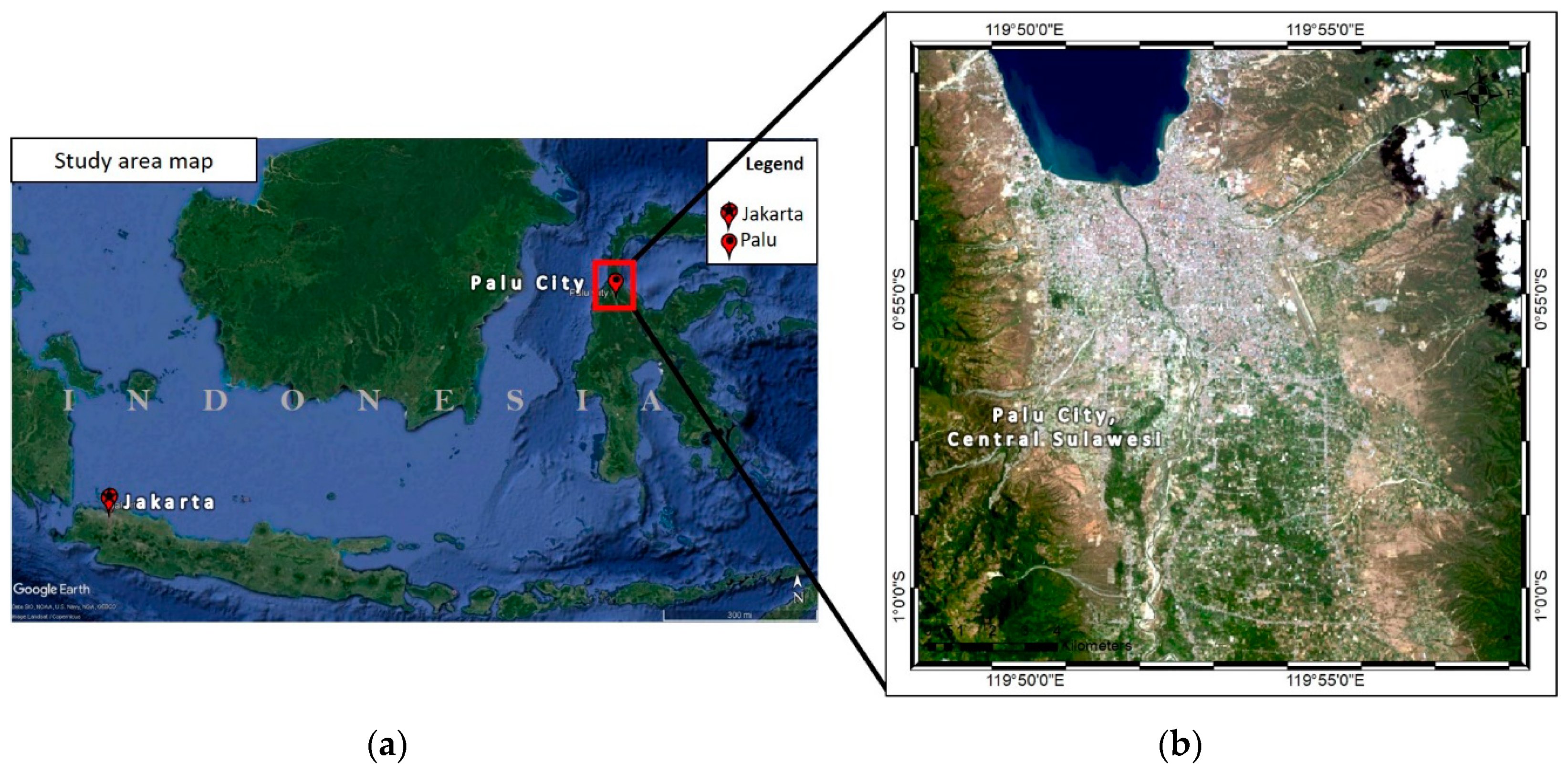
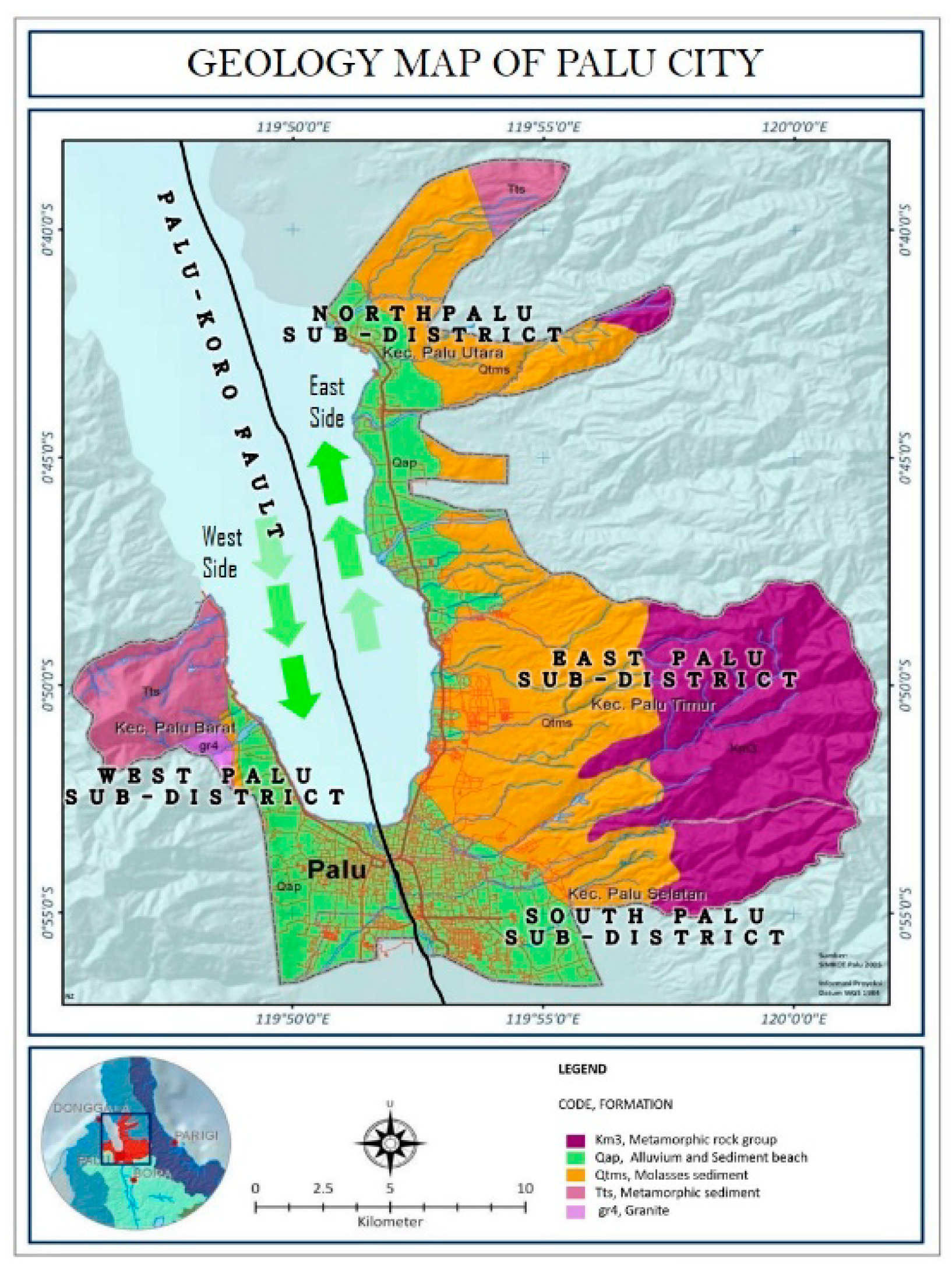

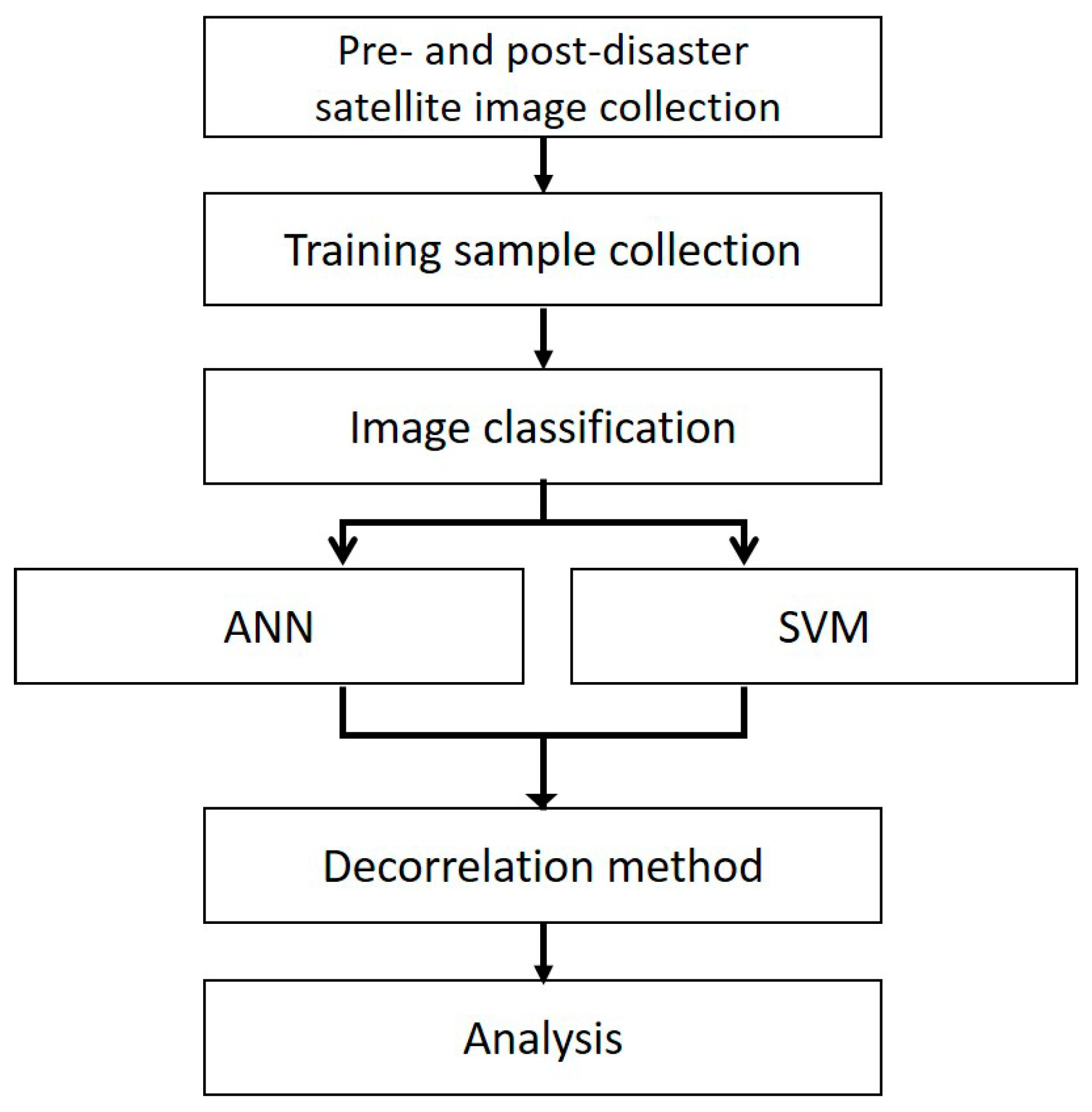

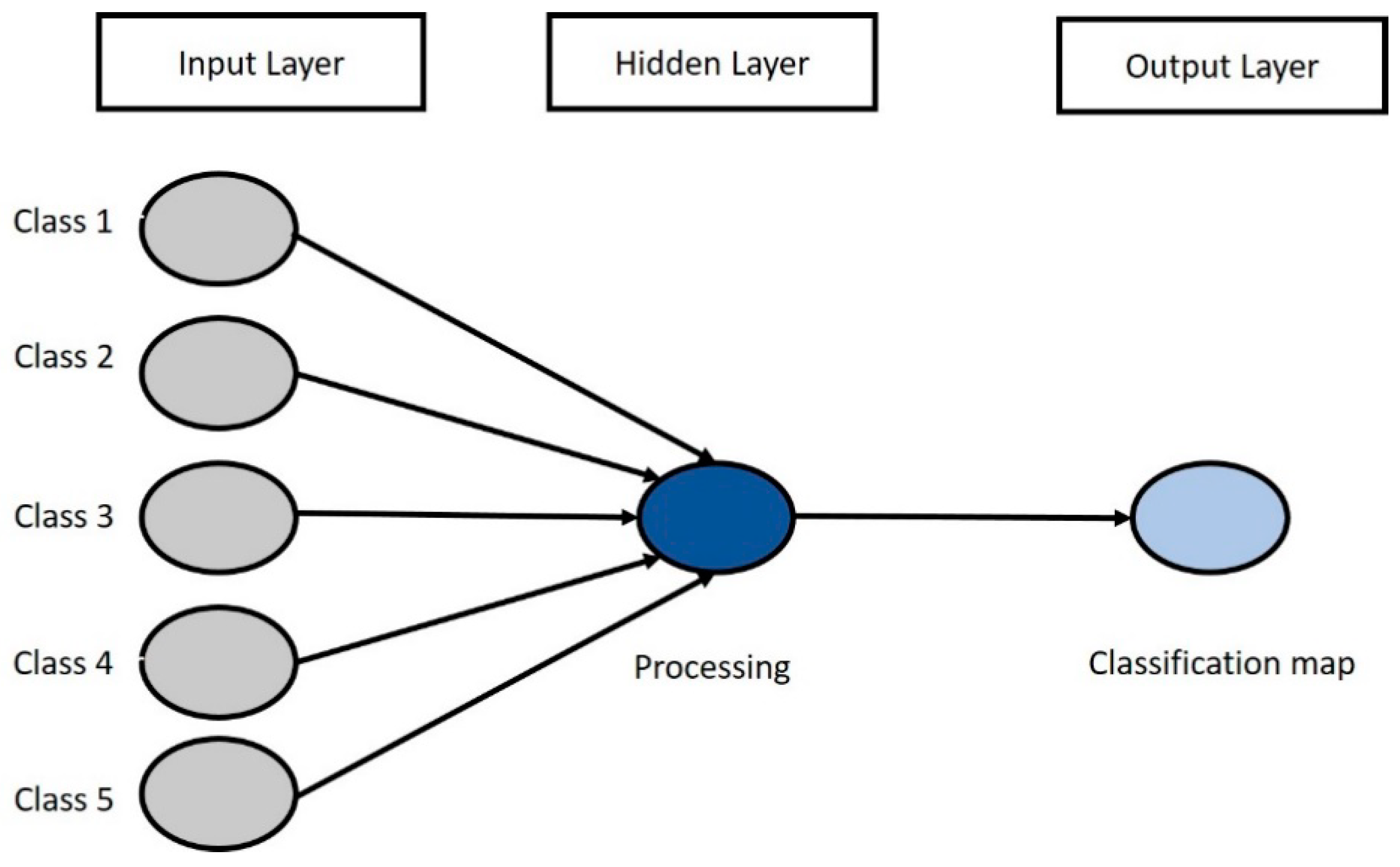

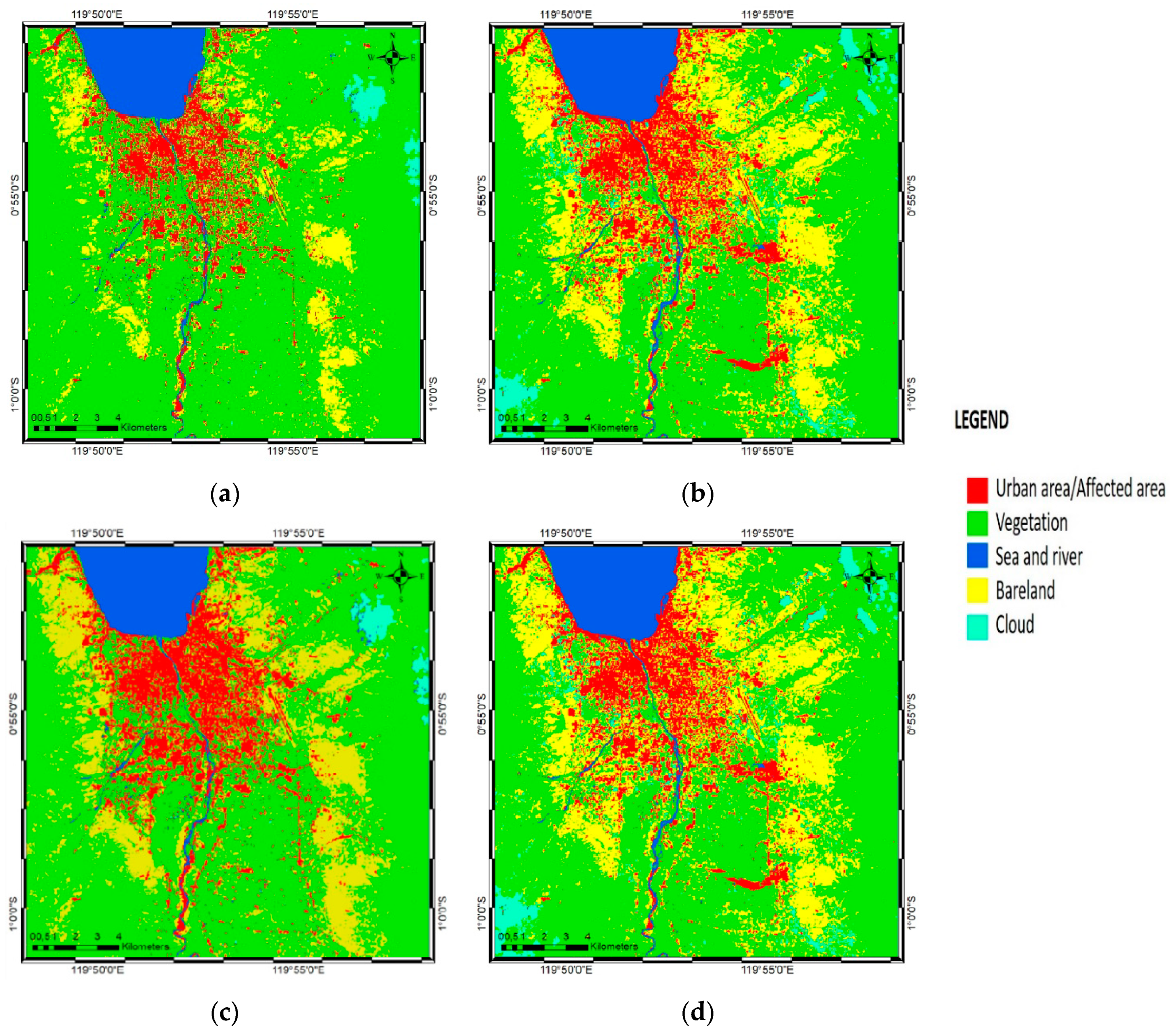
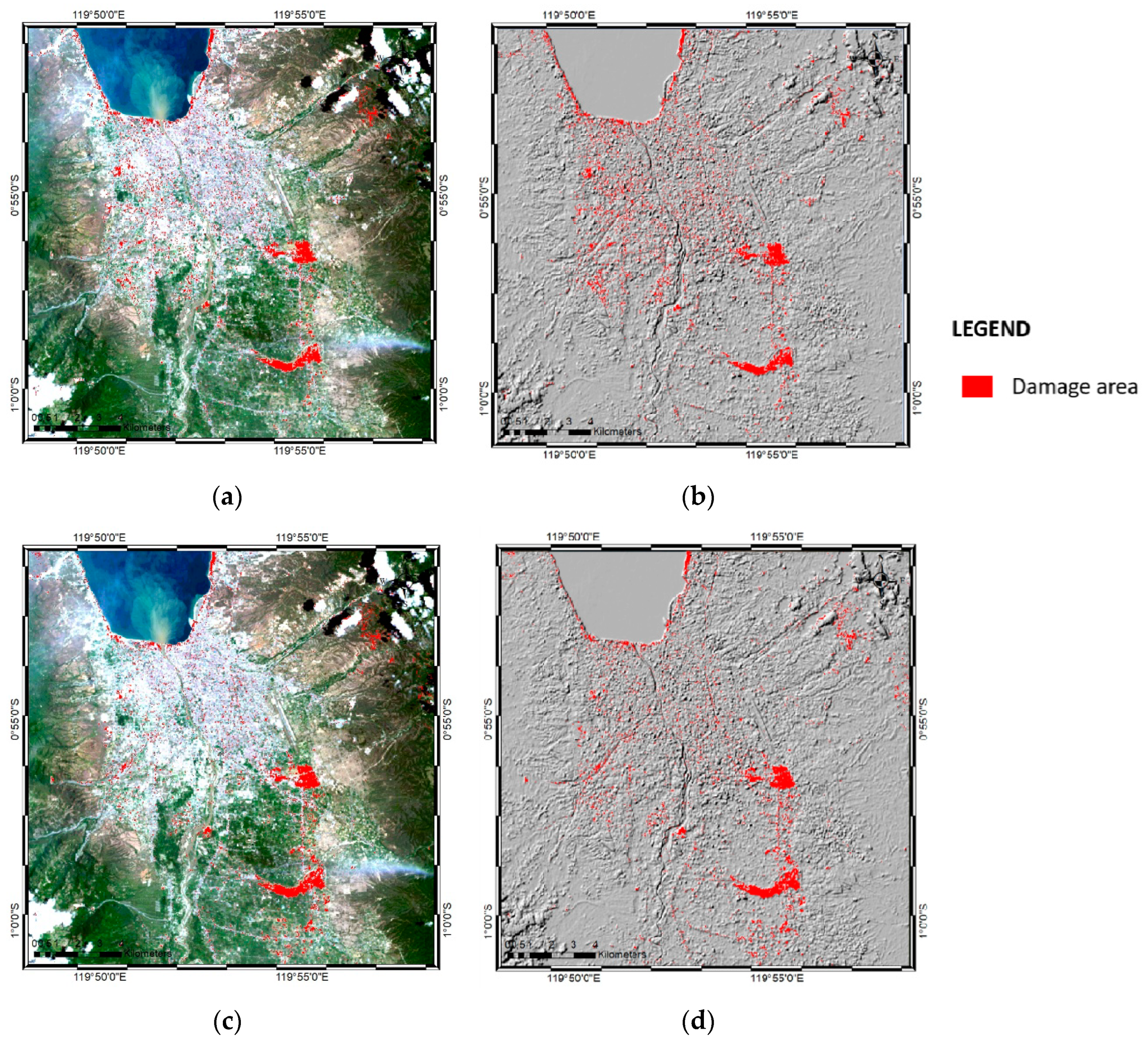
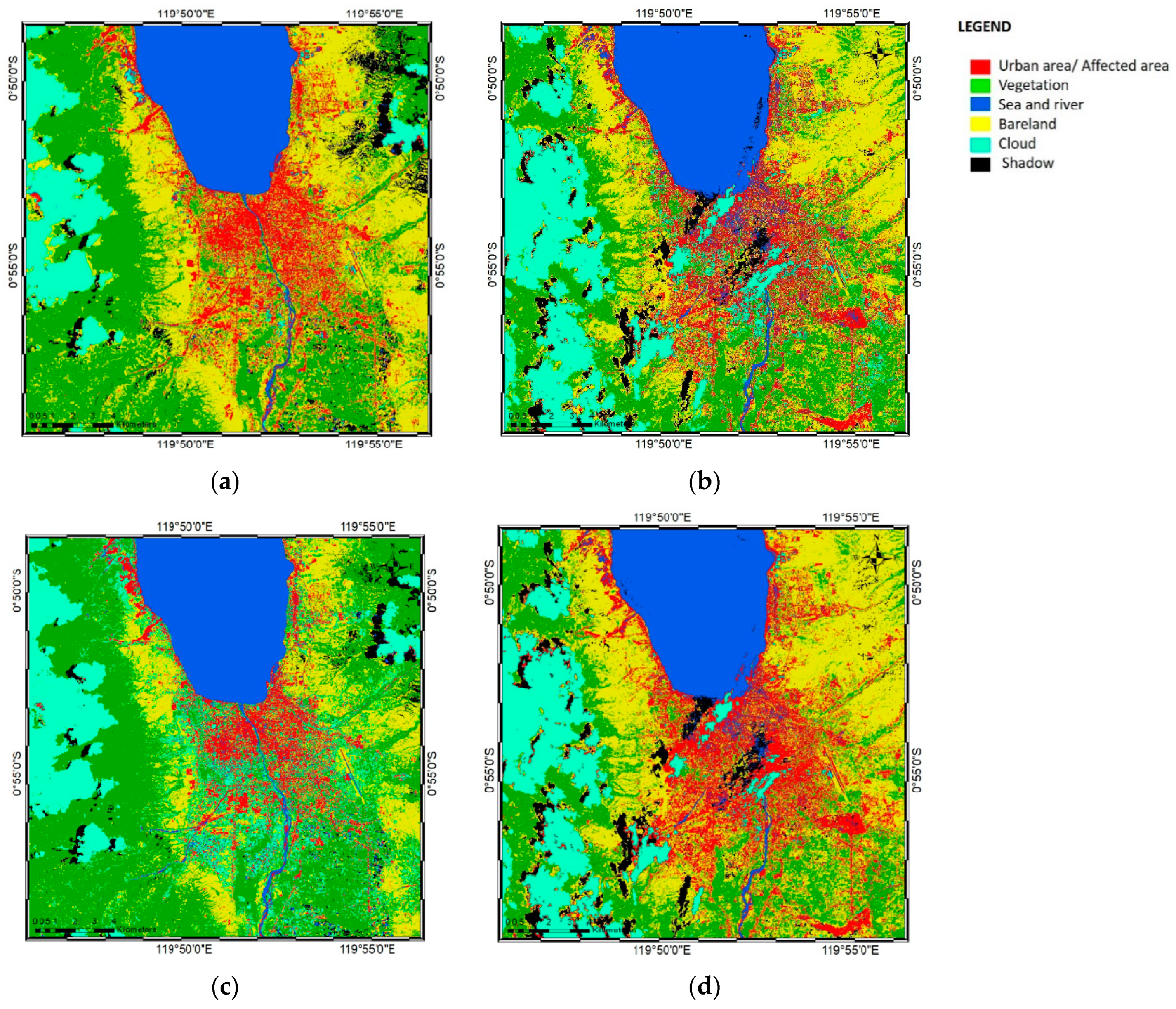

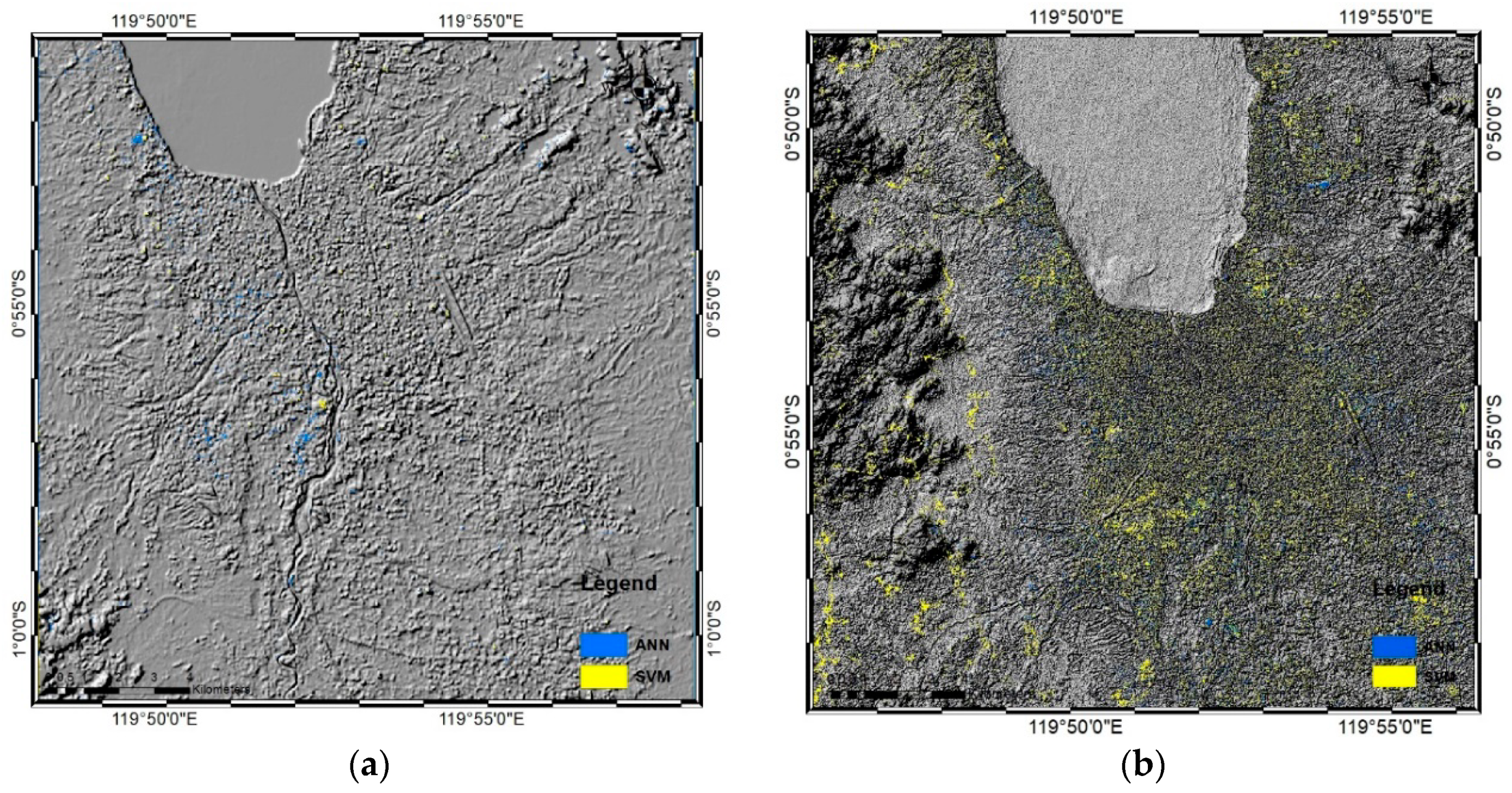
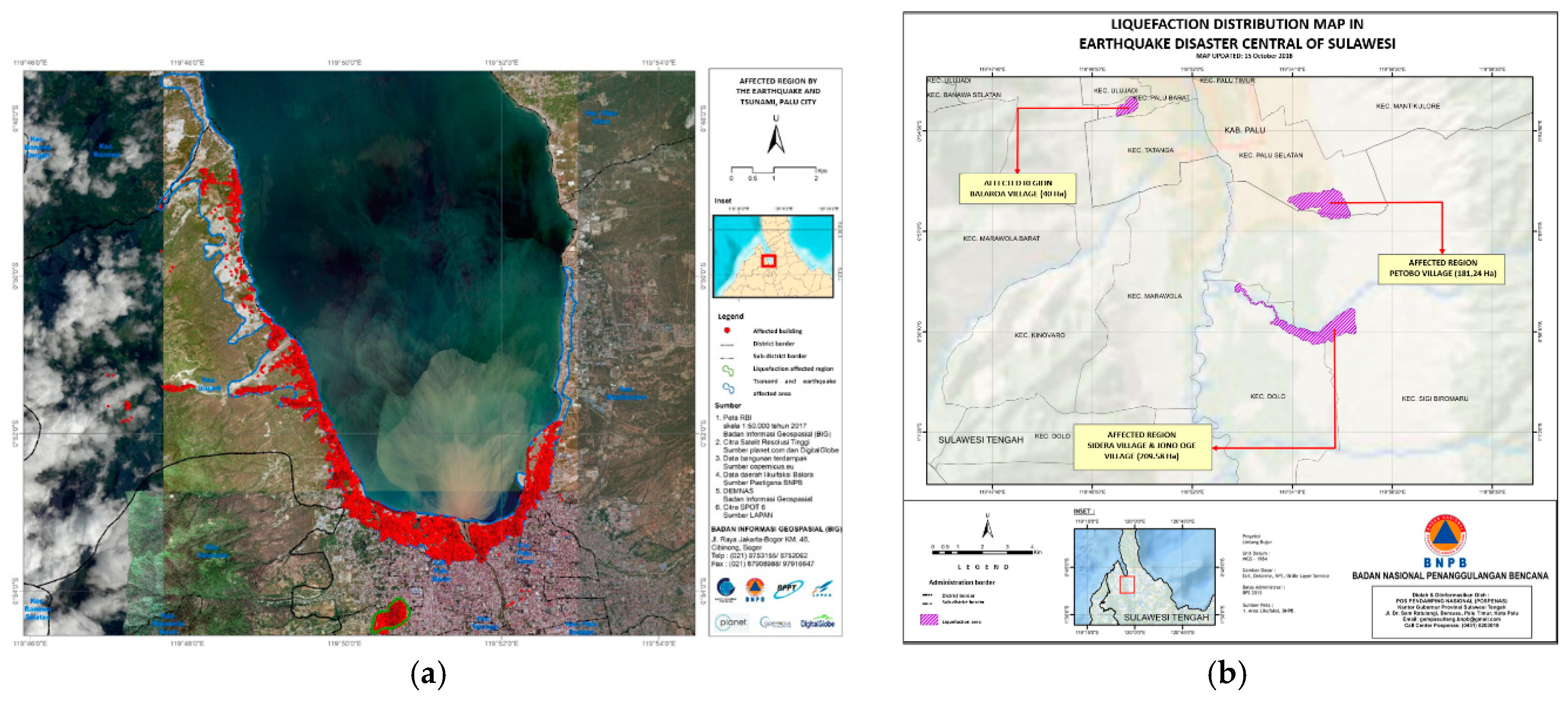
© 2019 by the authors. Licensee MDPI, Basel, Switzerland. This article is an open access article distributed under the terms and conditions of the Creative Commons Attribution (CC BY) license (http://creativecommons.org/licenses/by/4.0/).
Share and Cite
Syifa, M.; Kadavi, P.R.; Lee, C.-W. An Artificial Intelligence Application for Post-Earthquake Damage Mapping in Palu, Central Sulawesi, Indonesia. Sensors 2019, 19, 542. https://doi.org/10.3390/s19030542
Syifa M, Kadavi PR, Lee C-W. An Artificial Intelligence Application for Post-Earthquake Damage Mapping in Palu, Central Sulawesi, Indonesia. Sensors. 2019; 19(3):542. https://doi.org/10.3390/s19030542
Chicago/Turabian StyleSyifa, Mutiara, Prima Riza Kadavi, and Chang-Wook Lee. 2019. "An Artificial Intelligence Application for Post-Earthquake Damage Mapping in Palu, Central Sulawesi, Indonesia" Sensors 19, no. 3: 542. https://doi.org/10.3390/s19030542
APA StyleSyifa, M., Kadavi, P. R., & Lee, C.-W. (2019). An Artificial Intelligence Application for Post-Earthquake Damage Mapping in Palu, Central Sulawesi, Indonesia. Sensors, 19(3), 542. https://doi.org/10.3390/s19030542





